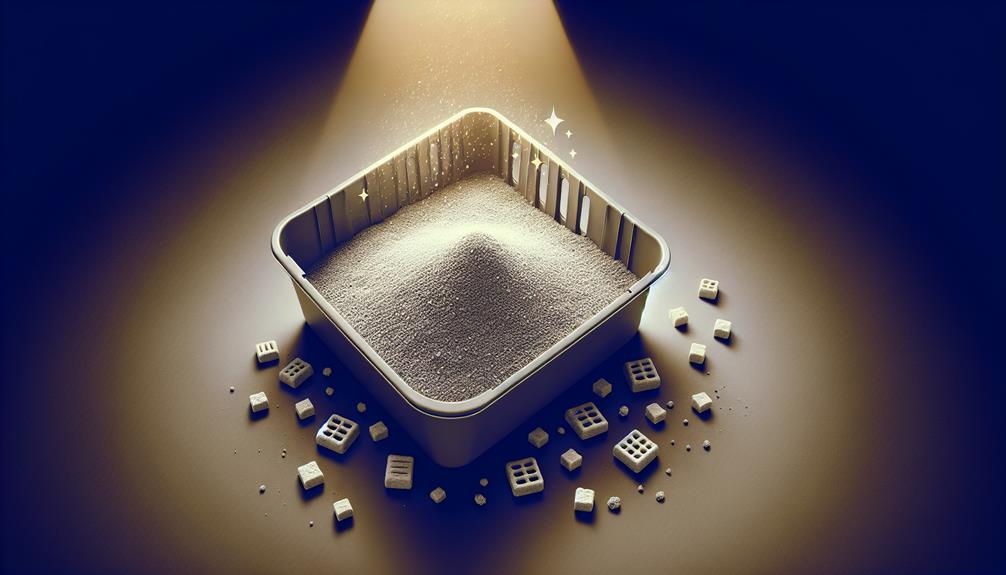The world of cat litter is vast and varied, with options to suit every feline companion and their human counterparts. From clumping to non-clumping varieties, the choices can be overwhelming.
Natural and biodegradable options have gained popularity in recent years, offering an environmentally friendly alternative. The debate between scented and unscented litter continues to divide opinions among cat owners.
However, beyond these basic considerations lies a realm of tips and tricks for maintaining a clean and odor-free litter box that every cat parent should be aware of.
Key Takeaways
- Choose litter based on cat's preferences and owner's priorities.
- Regular maintenance ensures odor control and cat's health.
- Consider environmental impact and cost when selecting litter type.
- Monitor cat's reaction to scented or unscented options for optimal litter choice.
Types of Cat Litter
There are four main types of cat litter commonly used by pet owners.
The first type is clay litter, which is a popular choice known for its affordability and ability to absorb moisture and control odors effectively. Clay litter comes in both clumping and non-clumping varieties, offering options for different preferences.
Another common type is silica gel litter, made from silica sand that absorbs liquid and traps odors, keeping the litter box fresh for longer periods.
Plant-based litter, such as pine, wheat, or corn, is an eco-friendly alternative that is biodegradable and offers natural odor control.
Finally, there is also crystal litter, which is made from absorbent silica gel crystals that provide excellent odor control and can last longer between changes compared to other types.
Each type of cat litter has its own advantages, so pet owners can choose the one that best suits their cat's preferences and their own lifestyle.
Clumping Vs. Non-Clumping
When considering the choice between clumping and non-clumping cat litter, pet owners must weigh the pros and cons of each type to determine which option best aligns with their cat's needs and their own preferences.
- Clumping litter forms solid clumps when in contact with moisture, making it easier to scoop out waste.
- Non-clumping litter absorbs urine but does not form clumps, requiring more frequent changing of the entire litter box.
- Clumping litter tends to control odors more effectively by trapping them within the clumps.
- Non-clumping litter may be less expensive upfront but could lead to higher long-term costs due to more frequent complete litter box changes.
- Some cats, especially kittens, might ingest clumping litter, which can be harmful if not attended to promptly.
Understanding these differences can help cat owners make an informed decision based on their cat's habits and preferences, ultimately creating a more comfortable and hygienic environment for both the cat and its owner.
Natural and Biodegradable Options
Exploring environmentally-friendly alternatives, cat owners can consider natural and biodegradable options for cat litter. These options are gaining popularity among pet owners who are increasingly conscious of their environmental impact. Natural cat litters are typically made from renewable resources such as corn, wheat, pine, or paper. These materials are biodegradable, meaning they break down easily, reducing the amount of waste that ends up in landfills. Biodegradable cat litters are also often free from harmful chemicals and additives, making them a safer choice for both cats and their owners.
One key benefit of natural and biodegradable cat litters is their eco-friendliness. By choosing these options, cat owners can minimize their carbon footprint and contribute to a more sustainable planet. Additionally, many natural cat litters offer excellent odor control and clumping abilities, making them a practical choice for busy cat owners. While natural and biodegradable cat litters may be slightly more expensive than traditional options, the peace of mind that comes with using a sustainable product is priceless for many environmentally-conscious cat owners.
Scented Vs. Unscented Litter
Natural and biodegradable cat litters offer eco-conscious pet owners the choice between scented and unscented options to suit their preferences and needs. Scented litter can help mask odors, making the litter box more pleasant for both cats and owners. On the other hand, unscented litter may be preferred by cats with sensitivities to fragrances.
Here are some factors to consider when choosing between scented and unscented cat litter:
- Cat Preferences: Some cats may be picky about scented litters and prefer the natural scent of unscented options.
- Odor Control: Scented litters are designed to control odors, while unscented litters rely on other methods such as absorbing moisture to reduce smells.
- Sensitivities: Cats with allergies or sensitivities may react negatively to the artificial fragrances in scented litter.
- Cost: Scented litters often come at a higher price point due to the added fragrances, while unscented options may be more budget-friendly.
- Environmental Impact: Consider the environmental impact of scented litters, as some fragrances may not be eco-friendly.
Tips for Litter Box Maintenance
Considering the importance of a clean and well-maintained litter box for both your cat's health and your household's hygiene, implementing effective tips for litter box maintenance is essential. Regular maintenance not only ensures your cat has a pleasant place to do their business but also helps in keeping your home odor-free. Here are some practical tips for maintaining your cat's litter box:
| Tips for Litter Box Maintenance | Description |
|---|---|
| Scoop Daily | Remove waste and clumps daily to prevent odor and keep the litter fresh. |
| Replace Litter Regularly | Completely change the litter at least once a week to maintain cleanliness. |
| Clean the Box Weekly | Wash the litter box with mild soap and water weekly to prevent bacterial growth. |
Frequently Asked Questions
Can Cat Litter Be Flushed Down the Toilet?
Flushing cat litter down the toilet is not recommended. It can cause blockages in the plumbing system and harm the environment.
Cat litter often contains materials that do not break down easily and can clog pipes.
It is best to dispose of cat litter in the trash or look for environmentally friendly alternatives that can be safely composted or disposed of according to local regulations.
How Often Should Cat Litter Be Completely Changed Out?
Regularly changing out cat litter is crucial for maintaining a clean and healthy environment for your feline companion.
The frequency of complete litter changes depends on factors like the type of litter used, the number of cats in the household, and individual cat preferences.
Generally, it is recommended to completely change out cat litter at least once a week to prevent odors, maintain cleanliness, and ensure your cat's comfort and hygiene.
Are There Any Health Risks Associated With Certain Types of Cat Litter?
Certain types of cat litter can pose health risks to both pets and their owners. For example, some clumping litters contain sodium bentonite, which can cause gastrointestinal blockages if ingested by cats. Additionally, certain types of litter can generate dust particles that may exacerbate respiratory issues in both cats and humans.
It is important to research and choose cat litter options carefully to minimize potential health hazards.
What Is the Best Way to Dispose of Used Cat Litter?
Proper disposal of used cat litter is crucial to prevent environmental contamination and health risks. Individuals should avoid flushing litter down toilets as it can harm plumbing systems and contaminate water sources.
The recommended method is to securely bag the used litter and dispose of it in the regular trash. This helps contain any potential pathogens and prevents them from entering the environment, ensuring a safe and clean living space for all.
Are There Any Alternative Uses for Used Cat Litter?
Repurposing used cat litter can be beneficial in various ways. Some alternatives include using it as a natural fertilizer for non-edible plants, absorbing oil spills in the garage or driveway, or serving as a natural pest deterrent in gardens.
The absorbent nature of cat litter can be utilized in different settings, showcasing its versatility beyond its traditional use. Consider these options to give used cat litter a new purpose while minimizing waste.
Conclusion
In conclusion, the choice of cat litter can greatly impact the cleanliness and odor control of a litter box.
Different types of litter, such as clumping vs. non-clumping and scented vs. unscented, offer various benefits and drawbacks.
Maintaining a clean litter box is essential for a cat's health and comfort.
By exploring the different options available and understanding the importance of proper litter box maintenance, cat owners can ensure a pleasant environment for their feline companions.

